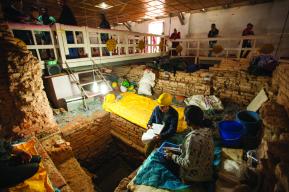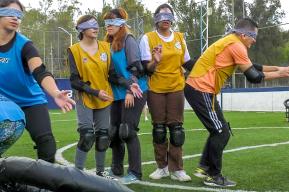Overlooking the Chao Phraya River as it follows its majestic course under the iconic Rama VIII Bridge, the portico balcony of Tamnak Yai—the principal building of Devavesm Palace in Bangkok, Thailand—affords a view at once serene and spectacular.

‘Not many people get to enjoy this view every day’, said Sumaivadee Mekasut, Assistant Director for Learning Center Management at the Bank of Thailand (BoT)—the present owner of Devavesm Palace. Ms Sumaivadee has worked at the BoT for 37 years now, the first 17 of which were spent as an archivist, before she devoted herself to caring for precious collections in the BoT Museum and giving bespoke heritage tours for special guests of the BoT.

Now approaching retirement, Ms Sumaivadee recollected numerous fond memories of Devavesm Palace, such as how the third-storey bedchamber at Tamnak Yai once served as an office for BoT Museum staff. Pointing to the far corner of the room, she said, ‘I used to sit right there.’

She also recounted that during dress rehearsals for the royal barge procession (a centuries-old ceremony for occasions of great cultural and religious significance), the exquisitely ornate barges would assume their fleet formation not far upriver from the Floating House, one of the four subsidiary buildings of Devavesm Palace still extant today. Finishing her work in the late afternoon, Ms Sumaivadee would find herself just in time to behold them from the vantage point of Tamnak Yai as they made their graceful journey to Wat Arun (Temple of Dawn).

She explained that distinguished guests—among them the late Queen Elizabeth II, who visited Thailand in November 1996 as part of celebrations marking the 50th anniversary of King Rama IX’s accession to the throne—could witness the procession up close from the Floating House itself.

Devavesm Palace was constructed between 1914 and 1918 at the behest of King Vajiravudh (Rama VI). The palace was a gift to the king’s uncle, Prince Devawongse Varopakarn (1858–1923), whose distinguished tenure as foreign minister spanned the reigns of King Rama V and King Rama VI.

Prince Devawongse was personally involved in the selection of construction and decoration materials for Tamnak Yai. For instance, according to Saranya Buranavittayawut, Associate Director for Facilities Engineering Systems Management at the BoT, the prince was initially offered white roof tiles, but he refused them and insisted on the installation of red ones.

‘The architectural design reflects the prince’s outlook’, observed Ms Saranya. In contrast to the exuberant Neo-Baroque style of nearby Bang Khun Phrom Palace, the Neoclassical balance and elegant simplicity of Devavesm Palace perhaps reveal something of the prince’s analytical mind—the very mind responsible for developing Thailand’s first solar calendar, in which the name of each month is suffixed according to its number of days.

‘The Neoclassical style of Tamnak Yai was appropriately adapted to our tropical climate, featuring windows that were designed to provide good ventilation during the summer’, Ms Saranya explained.
‘Few people are aware that the panels underneath the windows can be opened as well’, Ms Sumaivadee remarked before proceeding to open one. ‘And when it rains, I would rush to help the housekeeping staff close all the windows’, she added good-humouredly.

Upon Prince Devawongse’s death in 1923, his heirs inherited Devavesm Palace and resided there until the Ministry of Public Health bought the land and buildings in 1950. When the BoT acquired ownership of the estate in 1987, a masterplan was devised whereby the two riverside palaces of Devavesm and Bang Khun Phrom would be preserved as scenic landmarks, while a new BoT head office building (“Building 1”) would be expressly designed to serve as a more modern backdrop to harmoniously complement the combined heritage sites.
Ms Saranya related that she fell in love with the place as an undergraduate student at Silpakorn University, where she majored in architecture and thus had a chance to accompany a professor on a visit to neighbouring Bang Khun Phrom Palace. ‘It’s so beautiful’, she said. ‘I wanted to work here.’ Her big chance arrived in 1993, when the BoT was seeking an architect to oversee the massive revitalization project of the Devavesm Palace grounds and buildings. Ms Saranya jumped at the opportunity and joined the restoration effort at Tamnak Yai.

‘The BoT worked closely with the Fine Arts Department to ensure authentic restoration’, said Ms Saranya. At Tamnak Yai, every minutia was scrutinized. The provenance of handles and hinges for doors and windows was ascertained. Hair dryers were brought in to carefully melt away accumulated layers of repainting and expose the original colour. Moreover, Ms Sumaivadee mentioned that any new addition, such as the air conditioning system, was installed in an unintrusive and aesthetically thoughtful way.
Every aspect of the restoration process was meticulously documented, and permanent exhibits dedicated to the conservation project, as well as to Prince Devawongse’s life and work, are now housed in two rooms on the ground floor of Tamnak Yai.

The impressive restoration of Tamnak Yai at Devavesm Palace received an Honourable Mention in 2005 as part of the UNESCO Asia-Pacific Awards for Cultural Heritage Conservation, which have been recognizing the successful conservation of structures, places and properties of heritage value in the region over the past two decades. The award citation highlighted the ‘sophisticated research into the historic building fabric, deployment of appropriate building materials and techniques, and sensitive adaptations for modern use.’
Today, Devavesm Palace continues to be fastidiously maintained. ‘The ground floor of Tamnak Yai is cleaned every morning, and the upper floors every afternoon’, noted Ms Sumaivadee. One key issue that has required close attention was the gradual leaning of Tamnak Yai, which likely resulted from its soft riverside foundations. Indeed, a sense of incline towards the Chao Phraya River is markedly perceptible when one stands on the second-floor balcony. Nevertheless, Ms Saranya affirmed that measures have been taken to mitigate the impact of the leaning, and that Tamnak Yai is regularly monitored to ensure its stability and safety.

The spirit of a place may be preserved and honoured through material authenticity and integrity. But ultimately, that spirit becomes imbued with human significance when it is rendered expressive by the people who cherish and lovingly look after the place—those dedicated few whose own life stories and aspirations have become closely intertwined with the heritage that they strive every day to safeguard for future generations.

This is a lightly adapted version of an article that first appeared in the Bangkok Post, 21 August 2023.
#CultureForSustainableDevelopment

To learn more about the UNESCO Asia-Pacific Awards for Cultural Heritage Conservation (#HeritageAwards), please visit the project page here.
More from UNESCO Bangkok
Share
About the authors

Chairat Chongvattanakij is a Thai-Canadian consultant specializing in content creation for the Public Information and Outreach team at UNESCO Regional Office in Bangkok. He supports UNESCO in reporting, translation, media development and related projects in Asia and the Pacific.
In addition to his experience as a professional translator, Chairat is an accomplished pianist and music educator who holds a Doctor of Musical Arts degree from the University of Toronto, where he taught music theory and piano literature at the Faculty of Music. He has presented research papers at international academic conferences and delivered guest lectures and masterclasses at Mahidol University and Yamaha Music Academy Bangkok.









